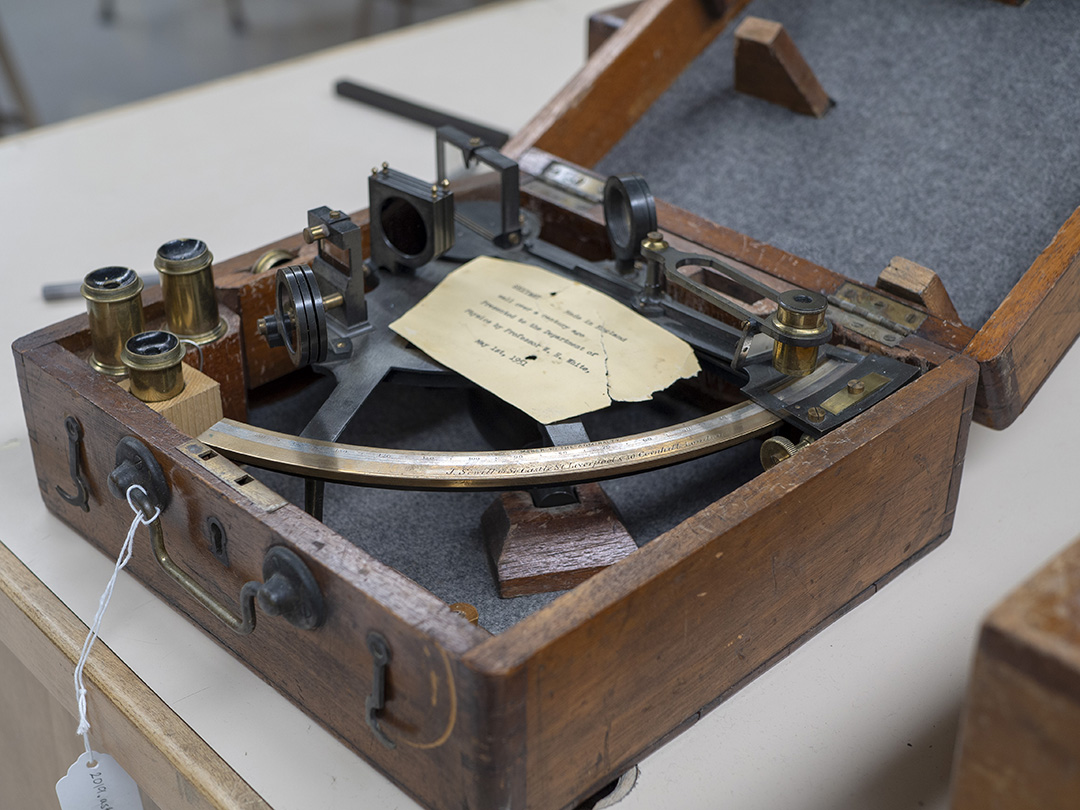
Rediscovering Saskatchewan’s scientific heritage
Delicate brass instruments, hand-blown tubes of glass, spinning gizmos, and perplexing bundles of wood and wire.
By Chris PutnamGathered together from every corner of the University of Saskatchewan (USask) Department of Physics and Engineering Physics, the unique collection of scientific artifacts fills two rooms in the Physics Building.
The items—some of them more than 150 years old—have been brought out of storage this summer so that a formative era of Canada’s scientific history can be better understood.
“We had all of these artifacts in storage, and they’ve been taken care of for decades. But they had been sitting, slowly being forgotten, and I thought it would be good to preserve them by basically finding out what’s here, what’s valuable,” said Dr. Mark Wurtz (PhD), an instructional assistant in the physics and engineering physics department of the College of Arts and Science.

The perfect opportunity arose when the department connected with Victoria Fisher, a PhD candidate in the history of science from the University of Toronto.
For her PhD research, Fisher is traveling to universities across Canada to study collections of scientific objects from the early 20th century. She was keen to see the USask physics department’s extensive collection.
With the help of graduate students, Wurtz gathered and sorted dozens of historical items: teaching tools, experimental instruments and some objects with unknown purposes.
Fisher arrived on June 16 and spent 10 days studying the collection.
“One of the things I really like about doing what I’m doing … is walking into a room and seeing all these objects and then getting a closer look at them and being able to figure out some of these stories,” said Fisher.
Founded in 1910, the USask physics department coped with geographic isolation and budget limitations in its early years. Research and teaching instruments were often built from scratch—many of them by Albert Cox, the English instrument maker who established the university’s Physics Machine Shop in 1924.
One-of-a-kind objects such as those made by Cox are of particular interest to Fisher.
“It really shows me what is going on in that early period, how things were developing, what they really needed that they weren’t able to purchase or they weren’t able to import,” she said.
Fisher was also drawn to the assortment of instruments that were purchased and shipped from elsewhere. These tell the story of how Canada’s early community of physicists was connected to the wider scientific world, she noted.
Some of the objects were harder to identify.

“There are always mysteries in a collection like this about what the objects do. They are so old that no one remembers what they do, what they did,” said Fisher.
To help solve the mysteries, the physics department invited its current and retired members to view the collection in June and record their memories of objects they recognized.
With help from the researchers and from archival documents, Fisher and Wurtz were able to identify many of the items, such as a mercury arc lamp made in 1923 by Professor E.L. Harrington, one of the department’s first faculty members.
A sextant built in England in the mid-1850s is likely the oldest item in the collection, said Wurtz. The astronomical instrument was donated as an antique in 1951 by Professor W.H. White.
The collection is not currently on view for the public, but the work put into labelling, cataloguing and photographing the objects will make it much easier for them to be exhibited in the future.
“That will give us the opportunity to take things out of storage more often, put things on display, and to come up with a plan in the future where we could have a place to put them,” said Wurtz.
Uncovering pieces of heritage and sharing them with Canadians is something that motivates Fisher’s research, she said.
“Basically every object has a story attached to it. There are no boring objects.”

